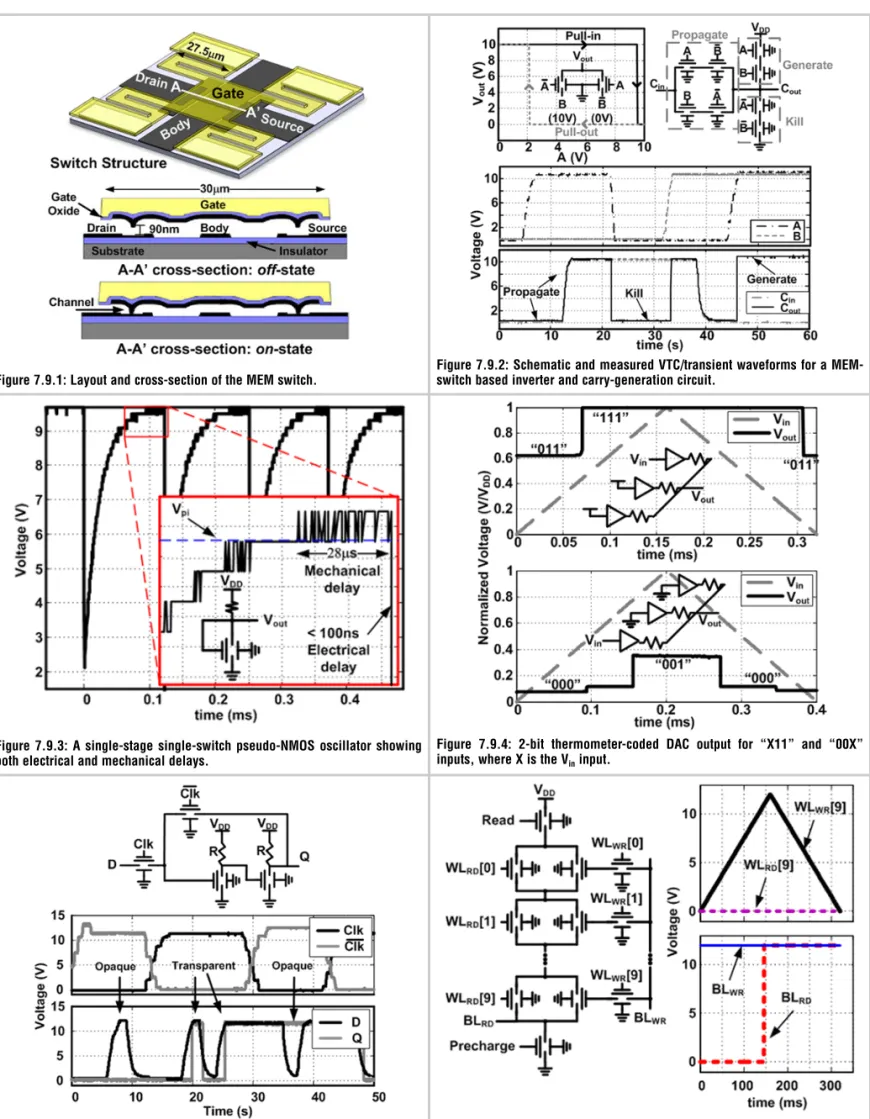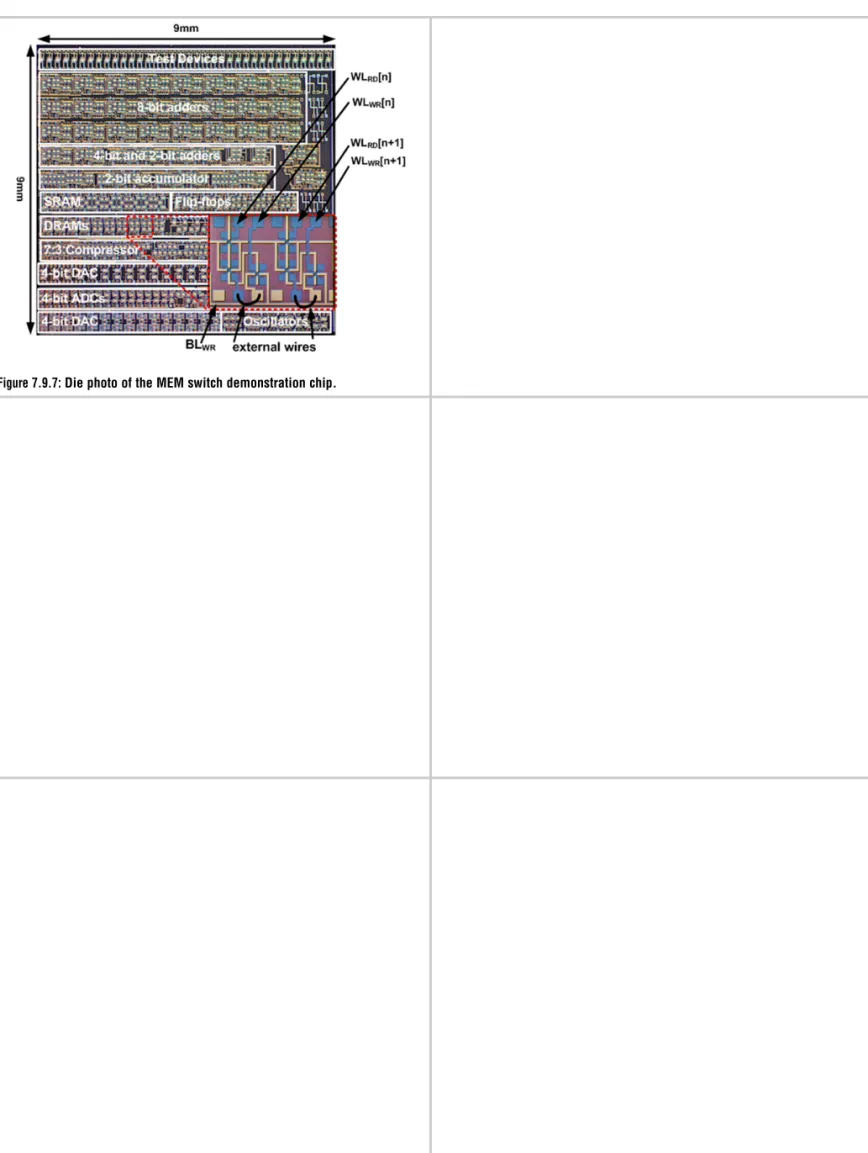Demonstration of Integrated
Mico-Electro-Mechanical Switch Circuits for VLSI Applications
The MIT Faculty has made this article openly available.
Please share
how this access benefits you. Your story matters.
Citation
Chen, F. et al. “Demonstration of integrated
micro-electro-mechanical switch circuits for VLSI applications.” Solid-State
Circuits Conference Digest of Technical Papers (ISSCC), 2010 IEEE
International. 2010. 150-151. © 2010, IEEE
As Published
http://dx.doi.org/10.1109/ISSCC.2010.5434010
Publisher
Institute of Electrical and Electronics Engineers
Version
Final published version
Citable link
http://hdl.handle.net/1721.1/60377
Terms of Use
Article is made available in accordance with the publisher's
policy and may be subject to US copyright law. Please refer to the
publisher's site for terms of use.
150
• 2010 IEEE International Solid-State Circuits Conference
ISSCC 2010 / SESSION 7 / DESIGNING IN EMERGING TECHNOLOGIES / 7.9
7.9
Demonstration of Integrated
Micro-Electro-Mechanical Switch Circuits for VLSI Applications
Fred Chen1, Matthew Spencer2, Rhesa Nathanael2, Chengcheng Wang3,
Hossein Fariborzi1, Abhinav Gupta2, Hei Kam2, Vincent Pott2,
Jaeseok Jeon2, Tsu-Jae King Liu2, Dejan Markovic3,
Vladimir Stojanovic1, Elad Alon2
1Massachusetts Institute of Technology, Cambridge, MA, 2University of California, Berkeley, CA,
3University of California, Los Angeles, CA
Due to transistor leakage, CMOS circuits have a well-defined lower limit on their achievable energy efficiency [1]. Once this limit is reached, power-constrained applications will face a cap on their maximum throughput independent of their level of parallelism. Avoiding this roadblock requires an alternate switching device with steeper sub-threshold slope—i.e., lower VDD/Ionfor the same Ion/Ioff [2]. One promising class of such devices with nearly ideal Ion/Ioffcharacteristics are electro-statically actuated micro-electro-mechanical (MEM) switches [6]. Although mechanical movement makes MEM circuit delay significantly larger than that of CMOS, we have recently shown that with optimized circuit topolo-gies MEM switches may potentially enable ~10x lower energy over CMOS at up to ~100MHz frequencies [3].
This work takes an initial step towards experimental validation of these princi-ples by leveraging recently developed switch technology and reliability enhance-ments [4,5] to demonstrate several monolithically integrated MEM switch-based building blocks. Specifically, our test vehicle (Fig. 7.9.7) includes logic, memo-ry, and clocking structures, and we demonstrate successful basic functionality and circuit composition.
Figure 7.9.1 shows cross-section and layout views of the MEM switch [4] used in this demonstration. The device is actuated by applying an electrostatic force between the poly-SiGe moveable gate electrode and the tungsten body electrode beneath it. When sufficient voltage (Vpi) is applied to “pull-in” the gate, a tung-sten channel (attached under the gate with an Al2O3gate oxide layer) snaps into contact with the tungsten drain and source electrodes. To turn the switch off (“pull-out” the channel), a lower gate-to-body voltage (Vpo) is required to reduce the electrostatic force below the spring restoring force of the gate when the switch is on. Endurance tests of the switch circuits on the demonstration test chip have yet to be performed, but previous results based on identical device designs indicate a lifetime greater than 109cycles [4]. Although the first
proto-type MEM switches and circuits were fabricated with conservative dimensions (in particular, an actuation gap size of 200nm resulting in ~10V operating volt-age), dimensional scaling is predicted to reap similar benefits in terms of supply voltage and energy as for CMOS [5].
Figure 7.9.2 shows the schematic and measured VTC of a MEM Inverter/XOR as well as transient waveforms for a carry-generation circuit demonstrating the use of the MEM switch as a logic element. The VTC of the XOR (B static at 10V) shows the expected hysteresis of the switch. This hysteresis window determines the minimum voltage swing required to switch the device on and off. Unlike CMOS, the MEM “NMOS-only” pass gate is capable of swinging full-rail at the output. This VTC shows that the device is capable of driving the necessary out-put voltages to overcome its own hysteresis window and switch another device. Like CMOS, this is a critical requirement to enable cascaded levels of digital logic.
The carry-generation circuit shown in Fig. 7.9.2 is designed such that during transients all of the switches will actuate at once and hence only a single mechanical delay is incurred. Circuits are designed this way due to the large dis-parity between electrical and mechanical time constants [3]. This is highlighted by Fig. 7.9.3, which shows the schematic and measured waveforms for a single switch pseudo-NMOS style oscillator. The waveforms enable calculation of the device’s on-resistance and mechanical delay. The rising edge is dominated by the RC time constant of the 100kΩ load resistor and the capacitance due to the test
infrastructure (probecard and oscilloscope), which is estimated to be 150pF. The oscillator’s falling edge sees the same load capacitance, but its delay is set by the on-resistance of the switch, which is estimated as 6kΩ for the sub-100ns falling edge. The mechanical delay of the device can be measured from the time the rising edge reaches Vpito when the switch actuates; due to the low gate over-drive, the mechanical delay is measured at ~20-30µs. The estimated capacitance of the switch-gate is ~375fF, resulting in an intrinsic electrical time constant of ~2ns.
The edge rate from the switch pull-down in the oscillator also demonstrates the device’s ability to drive capacitive loads. This indicates that the MEM switch may also be suitable as an I/O device. Figure 7.9.4 shows a 2-bit thermometer-coded DAC implemented using 3 MEM switch-based buffers. The measured waveforms show the DAC driving the two intermediate output levels.
The inverter, carry-generation circuit, oscillator, and DAC demonstrate the abili-ty of MEM switches to compute and communicate, to both perform logic func-tions and to drive loads. Figure 7.9.5 shows a MEM switch-based latch and measured transient waveforms demonstrating correct operation in both the opaque and transparent states. The output of the latch is isolated from the inputs with two resistively-loaded inverters that also drive the feedback keeper switch. Like in CMOS, a cascade of two latches can be used to create a flip-flop. Given its low leakage current [4], the switch is also well suited for DRAMs. Figure 7.9.6 shows a 10-bit DRAM column composed of MEM switches. The memory is constructed in a NAND configuration. The bit read line (BLRD) is pre-charged low and the word read line (WLRD[n]) is an active low signal that dis-ables the read pull-up path unless the stored bit is a “1”. The additional path of nominally on switches allows the memory to perform a read operation in a sin-gle mechanical turn-on delay (for decoding) plus a mechanical turn-off delay. Since the turn-off delay is much smaller than the turn-on delay, this configura-tion results in reduced read delay. Figure 7.9.6 also shows the measured results for the 10-bit memory cell, which was fully integrated except for (due to lack of vias) the wires between the drain of the storage device and the gate of the mem-ory device (Fig. 7.9.7). Due to measurement setup limitations, the pre-charge switch is bypassed with a 100kΩ pull-down resistor. The waveforms show a simultaneous memory write and read of the same bit.
This work demonstrates the feasibility of several computational and memory building blocks implemented using only passive components and MEM switch-es. As shown in the exemplary circuits, MEM switches are capable of driving each other to form composable digital circuits. Because of the disparity between their electrical and mechanical time constants, re-architecting at the circuit level is required to efficiently leverage their ideal Ion/Ioff characteristics. Although process scaling, device reliability, and circuit design challenges remain to be tackled before a MEM switch technology could offer an attractive alternative to CMOS, these initial circuit demonstrations confirm that MEM switches satisfy many of the basic requirements for eventually realizing this goal.
Acknowledgements:
This work was supported by the DARPA NEMS program, the C2S2 and MSD FCRP centers, BWRC sponsors, and NSF Infrastructure Grant No. 0403427. References:
[1] B. Calhoun, A. Wang, and A. Chandrakasan, “Modeling and Sizing for Minimum Energy Operation in Subthreshold Circuits,” IEEE JSSC, Sep. 2005. [2] H. Kam, et al., “Circuit Level Requirements for MOSFET Replacement Devices,” IEEE IEDM, Dec. 2008.
[3] F. Chen, et al., “Integrated Circuit Design with NEM Relays,” IEEE/ACM ICCAD, Nov. 2008.
[4] R. Nathanael, et al., “4-Terminal Relay Technology for Complementary Logic,” IEEE IEDM, Dec. 2009.
[5] H. Kam, et al., “Design and Reliability of a Micro-Relay Technology for Zero-Standby-Power Digital Logic Applications,” IEEE IEDM, Dec. 2009.
[6] K. Akarvadar, et al., “Design Considerations for Complementary Nanoelectromechanical Logic Gates,” IEEE IEDM, Dec. 2007.
151
DIGEST OF TECHNICAL PAPERS •
ISSCC 2010 / February 9, 2010 / 11:45 AM
Figure 7.9.1: Layout and cross-section of the MEM switch.
Figure 7.9.2: Schematic and measured VTC/transient waveforms for a MEM-switch based inverter and carry-generation circuit.
Figure 7.9.3: A single-stage single-switch pseudo-NMOS oscillator showing both electrical and mechanical delays.
Figure 7.9.5: Measured functionality of a MEM-switch based static latch.
Figure 7.9.6: Measured simultaneous read and write of a “1” to the bottom cell of a 10-cell 3-switch DRAM column.
Figure 7.9.4: 2-bit thermometer-coded DAC output for “X11” and “00X” inputs, where X is the Vininput.

